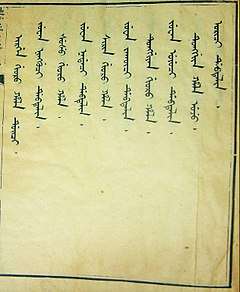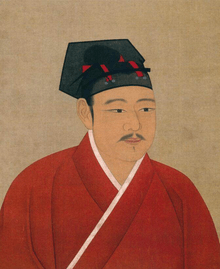Irgen Gioro
Irgen Gioro[3] (Manchu: ᡳᡵᡤᡝᠨ
ᡤᡳᠣᡵᠣ; Möllendorff: irgen gioro[6]) is a Manchu clan and family name, which was officially categorized as a "notable clan",[7] and member of the eight great houses of the Manchu nobility in Manchu Empire.[8][9][10][11][12][13] Sibe and Nanai people also has Irgen Gioro as their family name.[14][15]
| Irgen Gioro | |
|---|---|
 Irgen Gioro in Complete Genealogies of the Clans and Families of the Manchu Eight Banners | |
| Manchu | ᡳᡵᡤᡝᠨ ᡤᡳᠣᡵᠣ |
| Transliteration | Irgen Gioro(Möllendorff) |
| Ancestor | Emperor Huizong and Qinzong of Song? |
| Origin | Muki, Yehe, Jamuhu, Singgan, Sarkū, Hunehe, Yarhū, Girin Ula, Sunggari Ula, Akuri, Fe Ala, Hada, etc. |
| Notables | Asan Arjin Turusi Isangga Chang Shuhong |
| Branch | Donggo Bayara Monggero Laibu Siburu |
| Chinese surname | Zhao in majority |
History
The origin of Irgen Gioro does not have a decisive conclusion. According to a famous anecdote, the ancestors of Irgen Gioro were the emperors Huizong, Qinzong, and other imperial family members of Song dynasty who were captured by the Jurchens in the Jingkang Incident of the Jin–Song wars.[16][17] The Manchu emperors had also bestowed their family name to the founding ministers or generals who rendered outstanding service to the empire.[18] In order to differentiate from Aisin Gioro the Manchu imperial family,[19] "Irgen" was added with the meaning of "regular citizen" or "common people" and the implication of "non-imperial".[20][21]
At the early period of Manchu Empire, Irgen Gioro were recorded as 340 households.[22] They mainly distributed in Muki, Yehe, Jamuhu, Singgan, Sarkū, Hunehe, Yarhū, Girin Ula, Sunggari Ula, Akuri, Fe Ala, Hada, etc.[23] The whole clan had many famous hereditary noblemen in the empire, such as Viscount First Class Arjin and Asan of Muki; Viscount Third Class Turusi, Baron Second Class Fiyangū of Yehe and so on.[24] Among these noble families, Muki Irgen Gioro (also known as "Muki Gioro"[25]) was considered as the most politically influential one because of their important contribution to the Manchu Empire's establishment.[26] Irgen Gioro also earned numerous titles of minor nobility and 40 hereditary peers as captains (Manchu: ᠨᡳᡵᡠ
ᡳ
ᠵᠠᠩᡤᡳᠨ; Möllendorff: nirui janggin[27]) in Banner Armies.[28]
There were few instance of name change of the clan (e.g. The Manchu clan of Bayara, Monggero, Donggo, Laibu, and Siburu came from the Irgen Gioro who settled in these places.) at the early Qing Dynasty because of migration.[29] Due to the adoption of Chinese culture during the mid to late Qing dynasty, most of Irgen Gioro chose Zhao (simplified Chinese: 赵; traditional Chinese: 趙;Manchu: ᠵᠣᡠ; Möllendorff: Joo[30]), the first surname in the famous Hundred Family Surnames, as their Chinese family name. It was according to the Chinese homophone and their anecdote of origin.[31][32][33] Other utilization of Chinese family names, such as Tong, Gu, Yi, Sa, Gong, Zhao (兆), Cao, Bao, Zhe, Xi, Yu, Ge, Ma, Gao, Hu, Bai, and Chen, are also reported.[34]
Notable figures


Males
Ministers and Generals
| Name | Sub-clan | Remarks |
|---|---|---|
| Arjin | Muki | Hereditary Viscount First Class |
| Asan | Muki | Arjin's elder cousin, hereditary Viscount First Class |
| Fiyangū | Yehe | Hereditary Baron Second Class |
| Fulata | Neyin | Viceroy of Liangjiang and Minister of Justice |
| G'ag'ai[35] | Hunehe | a main creator of Manchu alphabet |
| Gūbadai | Sunggari Ula | Hereditary Master Commandant of Light Chariot, Minister of Rites |
| Isangga | Warka | Grand Secretariat of the Empire |
| Jinšun | Girin Ula | Ili General, earned a minor noble title of Knight Commandant of Cavalry and a warrior title of "Tulgeci Baturu" |
| Turusi | Yehe | Fiyangū's older brother, hereditary Viscount Third Class |
Prince Consort
| Date | Prince Consort | Princess |
|---|---|---|
| 1583 | Gahašan Hashū | Taksi's daughter (d. 1624) by Empress Xuan (Hitara Emeci) |
| 1644 or 1645 | Kuazha | Hong Taiji's sixth daughter (1633–1649) by secondary consort (Jarud Borjigit) |
| 1723 | Fusengge | Yinxiang's second daughter (1707–1726) by primary consort (Joogiya) |
Modern
| Name | Remarks |
|---|---|
| Chang Shuhong | the head of Dunhuang Research Academy |
| Zhao Ermi | Herpetologist and a member of the Chinese Academy of Sciences |
Females
Imperial Consort
| Imperial Consort | Emperor | Sons | Daughters |
|---|---|---|---|
| Secondary consort | Nurhaci | 7. Abatai, Prince Raoyumin (1589–1646) | 2. Princess (Yanzhe; 1587–1646) |
| Mistress | 7. Lady (1604–1685) | ||
| Hong Taiji | 7. Duke Cangšu (1637–1700) | ||
| Noble Consort Xun (1758–1798) | Qianlong Emperor | ||
| Concubine Rong (1837–1869) | Xianfeng Emperor |
Princess Consort
| Princess Consort | Prince | Sons | Daughters |
|---|---|---|---|
| Primary consort | Fiyanggū | 1. Natai (1632–1674) 2. Caigui (1636–1684) | |
| Mistress | Hooge, Prince Suwu | 7. Shushu (1645–1685) | |
| Primary consort | Prince Yunzhi | 1. Hongyu (1696–1718) | 1. Princess (1688–1711) 2. Princess (1689–1716) 3. Lady (1691–1723) 4. Lady (1692–1711) |
| Mistress | Yunzhi, Prince Chengyin | 3. Princess (1702–1746) | |
| Yunyou, Prince Chundu | |||
| Secondary consort | Yunti, Prince Xunqin | 3. Hongying (1707–1771) | 1. (b. 1705) 4. Lady (b. 1706) |
| Mistress | 7. Princess (b. 1753) | ||
| Primary consort | Prince Yunhu | 1. Prince Honglong (1727–1784) | 1. Princess (1730–1775) 2. Princess (1731–1785) |
| Secondary consort | Yonghuang, Prince Ding'an | 2. Mian'en, Prince Dinggong (1747–1822) | |
| Primary consort | Yongcheng, Prince Lüduan |
See also
References
Citations
- International Arts and Sciences Press 1982, p. 21
- 中国関係論說資料保存会 2004, p. 101
- Sometimes transliterated as IrgenGioro.[1][2]
- Vargyas 2015, p. 270)
- Hu 1994, p. 347
- Sometimes alternatively spelled "Irgen Giyoro"(ᡳᡵᡤᡝᠨ
ᡤᡳᠶᠣᡵᠣ[4][5]) in Manchu. - Hungjeo 2002, p. 181
- Rawski 1998, p. 66
- Elliott 2001, p. 398
- Chen 1997, pp. 229–230
- Xu 1986, pp. 2144–2145
- Yang 1933, pp. 1–2
- Jooliyan 1980, p. 316
- "Xibe Language Association of Xinjiang: Brief Introduction of Xibe Family Names (simplified Chinese)". Archived from the original on 2016-03-10. Retrieved 2012-11-09.
- Zhao & Yao 1997, p. 76(Zhuyeting Various Notes)
- Zhao 2012, p. 5
- American Geographical Society of New York 1940, p. 116
- Liu 2012, p. 4
- Zheng 2009, p. 44
- Elliott 2001, p. 133
- Norman 2013, p. 199
- Zhao 2012, p. 380
- Hungjeo 2002, pp. 179, 180, 189, 190, 199, 200, 207, 208, 209
- Zhao 2012, pp. 381–383
- 中国社会科学院近代史研究所政治史研究室 2011, p. 62
- Du 2008, p. 75
- Elliott 2001, p. 59
- Zhao 2012, pp. 491–519
- Zhao 2012, pp. 372, 373, 383, 384, 385
- Hu 1994, p. 876
- Jin, Jin & Ulhicun 1996, p. 207
- Jin 2009, pp. 118, 126
- Zhao 2012, pp. 5, 381
- Zhao 2012, p. 381
- Kanda 1956, p. 752
Sources
- American Geographical Society of New York (1940). Research Series, Volume 21. Oxford University Press.CS1 maint: ref=harv (link)
- Chen, Kangqi (1997). 郎潜纪闻初笔二笔三笔 (Langqian Notes 1st, 2nd and 3rd Edition). Zhonghua Book Company. ISBN 9787101017021.CS1 maint: ref=harv (link)(in Chinese)
- Du, Jiaji (2008). 八旗与清朝政治论稿 (The Political Papers of Eight Banners and Qing Dynasty). Renmin Publishing House. ISBN 9787010067537.CS1 maint: ref=harv (link)(in Chinese)
- Elliott, Mark C. (2001). The Manchu Way: The Eight Banners and Ethnic Identity in Late Imperial China. Stanford University Press. ISBN 0804746842.CS1 maint: ref=harv (link)
- Hu, Zengyi (1994). 新满汉大词典 (A Comprehensive Manchu-Chinese Dictionary). Xinjiang People's Publishing House. ISBN 9787228024049.CS1 maint: ref=harv (link)(in Chinese)
- Hungjeo (2002). 八旗满洲氏族通谱 (Eight Manchu Banners' Surname-Clans' Book). Liaohai Publishing House. ISBN 9787806691892.CS1 maint: ref=harv (link)(in Chinese)
- International Arts and Sciences Press (1982). Chinese Studies in History, Volumes 14-15. International Arts and Sciences Press.CS1 maint: ref=harv (link)
- Jin, Guangping; Jin, Qicong; Ulhicun (1996). 爱新觉罗氏三代满学论集 (The Paper Collection of Three Generations of Aisin Gioro). Yuanfang Publishing House. ISBN 9787805951485.CS1 maint: ref=harv (link)(in Chinese)
- Jin, Qicong (2009). 金启孮谈北京的满族 (Jin Qicong Talks About Beijing Manchus). Zhonghua Book Company. ISBN 7101068561.CS1 maint: ref=harv (link)(in Chinese)
- Jooliyan (1980). 啸亭杂录 (Xiaoting Various Records). Zhonghua Book Company. ISBN 9787101017519.CS1 maint: ref=harv (link)(in Chinese)
- Kanda, Nobuo, ed. (1956). Manwen Laodang: Taizu. Tōyō Bunko.CS1 maint: ref=harv (link)(in Japanese and Manchu)
- Liu, Qinghua (2012). 满族姓氏综录 (A Collective Record of Manchu Family Names) (in Chinese). Liaoning Minzu. ISBN 9787549702794.CS1 maint: ref=harv (link)
- Norman, Jerry (2013). A Comprehensive Manchu-English Dictionary (Harvard-Yenching Institute Monograph Series). Harvard University Asia Center; Bilingual edition. ISBN 9780674072138.CS1 maint: ref=harv (link)
- Rawski, Evelyn S. (1998). The Last Emperors: A Social History of Qing Imperial Institutions. University of California Press. p. 66. ISBN 052092679X.
Irgengioro.
CS1 maint: ref=harv (link) - Vargyas, Gábor (2015). A mártírium homályából (PDF) (in Hungarian). Pécsi Tudományegyetem Bölcsészettudományi Kar Interdiszciplináris Doktori Iskola Néprajz- és Kulturális Antropológia Tudományok Program.CS1 maint: ref=harv (link)
- Xu, Ke (1986). 清稗类钞 (Classified Collection of Qing Notes). Zhonghua Book Company. ISBN 9787101010732.CS1 maint: ref=harv (link)(in Chinese)
- Yang, Tonggui (1933). 沈故 (Old Story of Shenyang). Liaohai Book Company.CS1 maint: ref=harv (link)(in Chinese)
- Zhao, Erxun (2009). 清史稿 (Draft History of Qing). Zhonghua Book Compary. ISBN 9787101007503.CS1 maint: ref=harv (link)(in Chinese)
- Zhao, Li (2012). 满族姓氏寻人辞典 (Dictionary and Origin of Manchu Family Names) (in Chinese). Liaoning Nationality Publishing House. ISBN 9787549702862.CS1 maint: ref=harv (link)
- Zhao, Yi; Yao, Yuanzhi (1997). 簷曝杂记 竹叶亭杂记 [Yanpu Various Notes & Zhuyeting Various Notes] (in Chinese). Zhonghua Book Company. ISBN 9787101017489.CS1 maint: ref=harv (link)
- Zheng, Tianting (2009). 探微集 (Tanwei Collection) (in Chinese). Zhonghua Book Company. ISBN 9787101069853.CS1 maint: ref=harv (link)
- 中国関係論說資料保存会 (2004). 中国関係論說資料, Part 3 (Documentation of Chinese Relations, Part 3) (in Japanese). 中国関係論說資料保存会.CS1 maint: ref=harv (link)
- 中国社会科学院近代史研究所政治史研究室 (2011). 《清代满汉关系研究》 [A Study on Manchu-Han Relation in the Qing Dynasty] (in Chinese). 社会科学文献出版社. ISBN 9787509725917.CS1 maint: ref=harv (link)
| Eight Great Clans of Manchu Nobility | |
|---|---|
| Tunggiya | Gūwalgiya | Nara | Aisin Gioro | Tatara | Niohuru | Šumuru | Hešeri |
